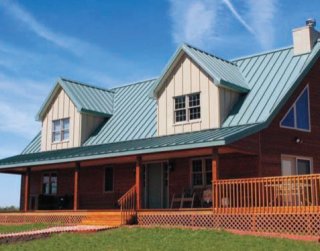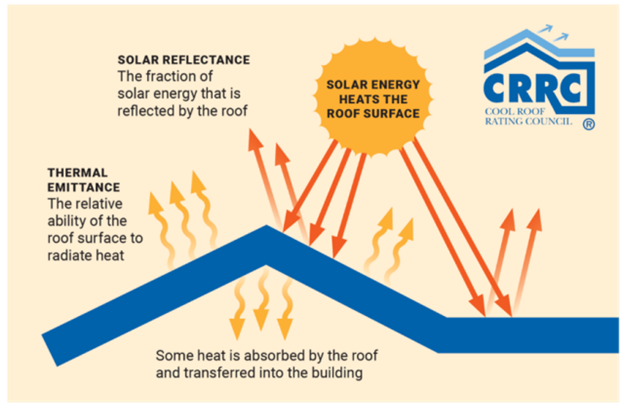Using Cool Roofs to Reduce Heat Islands
On this page:
- What is a Cool Roof?
- Products for Different Roofing Types
- Co-Benefits of Cool Roofs
- Types of Cool Roof Programs and Incentives
- More Information and Resources
What is a Cool Roof?
A cool roof absorbs and transfers less heat from the sun to the building compared with a more conventional roof. A high solar reflectance, or albedo, is the most important characteristic to understand in terms of how well a cool roof reflects heat from the sun away from a building. A high thermal emittance—how well a cool roof sheds the heat it does absorb—also plays a role, particularly in climates that are warm and sunny. Together, these properties reduce temperatures on the roof, inside the building, and in the surrounding ambient air.
Buildings with cool roofs use less air conditioning, save energy, and have more comfortable indoor temperatures. For example, in non-air-conditioned residential buildings, cool roofs can lower maximum indoor temperatures by 1.2–3.3°C (2.2 to 5.9°F).1
Cool roofs also impact surrounding areas by lowering temperatures outside of buildings and thus mitigating the heat island effect.
Products for Different Roofing Types
Building owners and roofing contractors have used cool roofing products for many years on commercial, industrial, and residential buildings. They may be installed on low-slope roofs (such as the flat or gently sloping roofs typically found on commercial, industrial, and office buildings) or the steep-sloped roofs used on houses and residential buildings.
The product technologies used for cool roofs vary by the roof’s type, as shown below.2
| Low-slope Cool Roof Products | Steep-slope Cool Roof Products |
|---|---|
|
|
The cost difference between a cool roof and conventional roofing materials varies by product type. Products that use certain reflective pigments (e.g., infrared reflective pigments) tend to cost more than products with conventional pigments. Ongoing costs of cool roofs may include periodic maintenance to keep the roof clean and maximize its reflectance, particularly for low-sloped cool roofs.
Cool walls—exterior walls that are made more reflective through white or light-colored paints or cladding or products that use special pigments—perform services similar to those of cool roofs. Their potential for heat reduction and energy savings is comparable to that of cool roofs across all of California and U.S. climate zones 1–4, especially on older structures where walls are typically less well-insulated than roofs.3
Co-Benefits of Cool Roofs
Cool roofs provide a number of benefits beyond urban heat island mitigation, including:

- Reduced energy use: A cool roof lowers the amount of heat transferred to the building, which allows it to stay cooler and use less energy for air conditioning. In air-conditioned residential buildings, solar reflectance from a cool roof can reduce peak cooling demand by 11–27%.1
- Reduced air pollution and greenhouse gas emissions: By lowering energy use, cool roofs decrease the associated air pollution and greenhouse gas emissions. When applied at a scale large enough to affect ambient temperatures, cool roofs could reduce the formation of ground-level ozone (which is heat-dependent)6 and reduce cooling energy use across a city.7
- Improved human health and comfort: Cool roofs can help reduce the adverse health impacts of heat islands, such as heat exhaustion, respiratory difficulties, dizziness and cramps, and heat-induced death. One United Kingdom study showed that cool roofs, when implemented across a city, could offset 18% of heat-related mortality associated with the heat island effect.8
Types of Cool Roof Programs and Incentives
Local, state, federal, and international building standards, as well as codes, ordinances, and financial incentives can be used to encourage the integration of cool roofs into other building improvement measures. Cool roof programs are often grouped into larger initiatives related to energy efficiency, green buildings, and climate change mitigation to name a few. These programs are typically managed by utilities and energy providers, state and local governments, and non-profit organizations. Requirements to meet standards or to qualify for incentives often take into account how much of the roof is covered in cool materials, roof slope, solar reflectance and thermal emittance values of the materials, and the nature of the property (e.g., residential, commercial, or other).9
The following examples of programs and incentives are from information published by the Cool Roof Rating Council, last updated in 2022.10 For the most current data, visit the Cool Roof Rating Council Codes and Programs page.
Building Standards
- Mandatory standards, codes, and ordinances: Cool roof requirements have been integrated into building and energy standards or ordinances in at least 13 cities and counties, seven states, and the District of Columbia. Example: Urban Heat Island Ordinance No. 2019-4252 (pdf) (1,300 KB) (City of Miami Beach, Florida)
- Voluntary programs: Eight voluntary programs for cool roofs are offered by international, national, and state agencies and organizations. These programs typically require that roofs meet a minimum solar reflectance level for the building to receive a certification or be designated as meeting a standard. Example: U.S. Green Building Council (LEED) Site Sustainability - Heat Island Reduction; Version 4.1
Financial Incentives
- Rebates: Rebate programs are typically run directly by utilities or by cities as a part of larger programs for energy efficiency upgrades. Thirty-five utility and municipal rebate programs for installation of cool roofs are available in 11 states, representing the most popular financial incentive program nationally for cool roofs. Example: Energy Cool Roof Rebate Program (San Antonio, Texas)
- Whole-Building Incentives: These financial incentives, which are based on overall reductions in facility energy use, are almost exclusively run by utilities and primarily affect new construction or total building retrofits. California, Minnesota, and Texas offer whole-building incentives for cool roofs. Example: Customized Retrofit Incentives from Pacific Gas and Electric (regionally available in California)
- Loans: Eight states run 11 programs for loans to partially cover the costs of installing and maintaining cool roofs. Example: Energy Conservation for Ohio (ECO-Link)
Local Government Cool Roof Program Examples
- EPA’s Heat Island Community Actions Database provides examples of local government programs, ordinances, climate action plans, construction codes, loan programs, and outreach programs that promote cool roofs and walls. Filter the “Cooling Activity” menu by “Cool Roofs” to view all cool roof-related programs.
More Information and Resources
EPA Resources
More details on cool roofs are available in Chapter Four of EPA’s Guide to Reducing Heat Islands. In addition, visit the Heat Island Webinars page and use the “Sort by Topic” filter to find past webinars on cool roofs and cool walls. The ENERGY STAR program has basic information on using cool roofs to save energy.
Non-EPA Resources
- Lawrence Berkeley National Laboratory - Heat Island Group
- Cool Roof Rating Council (CRRC) administers a rating program for companies interested in having their roofing and exterior wall products listed and labeled with information about the product’s surface radiative performance (solar reflectance and thermal emittance). The ratings help inform consumers about the product’s impact on a building's energy use and heat island reduction. The CRRC lists the rated products in its Rated Products Directories and provides additional resources such as:
- Database of State Incentives for Renewables & Efficiency
- U.S. Department of Energy Cool Roof Calculator
- Cool Savings Explorer (Lawrence Berkeley National Laboratory)
References
1. Synnefa, A., M. Santamouris, and H. Akbari. 2007. Estimating the effect of using cool coatings on energy loads and thermal comfort in residential buildings in various climatic conditions. Energy and Buildings 39, 1167–1174.
2. Cool Roof Rating Council. 2023. Low-Sloped Roofing Product Types; Cool Roof Rating Council. 2023. Steep-Sloped Roofing Products.
3. Rosado, P.J., Levinson, R. 2019. Potential benefits of cool walls on residential and commercial buildings across California and the United States: Conserving energy, saving money, and reducing emission of greenhouse gases and air pollutants. Energy and Buildings 199, 588-607.
4. Levinson, R., Akbari, H. 2010. Potential benefits of cool roofs on commercial buildings: conserving energy, saving money, and reducing emission of greenhouse gases and air pollutants. Energy Efficiency 3, 53–109.
5. Hosseini, M. 2014. Cool Roofs Savings and Penalties in Cold Climates: the Effect of Snow Accumulation on Roof (PDF) (108 pp, 7 MB). Concordia University, Montreal, Quebec, Canada.
6. Epstein S.A., Lee S.M., Katzenstein A.S., Carreras-Sospedra M., Zhang X., Farina S.C., Vahmani P., Fine P.M., Ban-Weiss G. 2017. Air-quality implications of widespread adoption of cool roofs on ozone and particulate matter in southern California. Proceedings of the National Academy of Sciences 22;114 (34), 8991-8996.
7. Yang J., Bou-Zeid E. 2019. Scale dependence of the benefits and efficiency of green and cool roofs. Landscape and Urban Planning 185, 127-140.
8. Macintyre, H.L. and C. Heaviside. 2019. Potential benefits of cool roofs in reducing heat-related mortality during heatwaves in a European city, 2019. Environment International 127, 430-441.
9. Cool Roof Rating Council. 2023. Looking for Cool Roof or Cool Exterior Wall Codes, Standards, and Voluntary Programs?
10. Cool Roof Rating Council. 2023. Resources: Codes and Programs. Data last updated in 2022.

